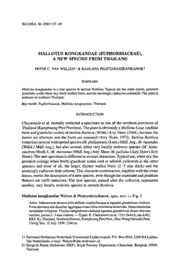
Mallotus kongkandae (Euphorbiaceae), a new species from Thailand PDF
Preview Mallotus kongkandae (Euphorbiaceae), a new species from Thailand
BLUMEA 46 (2001) 67-69 Mallotus kongkandae(Euphorbiaceae), a new species from Thailand Peter+C. van Welzen 1 & KI anlaya Phattarahirankanok Summary Mallotus kongkandaeis anewspecies in section Rottlera. Typicalarethe ovate leaves, greenish glandularscales whendry,thick-walled fruits,andthe seeminglycaducous columella. Theplantis endemic tonorthern Thailand. Key words:Euphorbiaceae,Mallotus kongkandae,Thailand. INTRODUCTION Chayamarit etal. recently collecteda specimen in one ofthe northernprovinces of Thailand(Kamphaeng PhetProvince). Theplant isobviously aMallotusLour,(stellate hairs andglandular scales) ofsectionRottlera(Willd.)AiryShaw(1968),becausethe leavesare alternateandthe fruits are unarmed(Airy Shaw, 1972). Section Rottlera comprises several widespread species (M.philippensis (Lam.) Mull.Arg.,M. repandus (Willd.) Miill.Arg.),but also several, oftenvery locally endemic species (M. lepto- stachyus Hook.f., M.montanus(Miill.Arg.)AiryShaw,M.pallidus(Airy Shaw)Airy Shaw).Thenewspecimen isdifferentinseveral characters.Typical are, whendry,the greenish (orange whenfresh) glandular scales (red or whitishyellowish intheother species) and most ofall, thelarger, thicker walledfruits (2-3 mm thick) and the seemingly caducousfruitcolumn.Thischaractercombination,togetherwiththeovate leaves,meritsthe description ofanewspecies, eventhoughthestaminateandpistillate flowers are (still)unknown. The newspecies, namedafterthe collector, represents another, very locally endemicspecies insectionRottlera. Mallotuskongkandae Welzen& Phattarahirankanok,spec. nov. —Fig. 1 Arbor. Indumentum densumpilis stellatissimplicibusqueetsquamis glandulosisviridulis. Folia alternataseddistaliter aggregataovatainfratomentosatrinervata. Infructescentiae terminales solitariae. Fructus subglobosuselobatussquamisglandulosisdenseobtectus inermis,paries 2-3mmcrassus.—Typus:K.Chayamaritetal. 1551 (holoL;isoAAU, BKF,K), Thailand,Northern District,KamphaengPhetProv.,MaeWongNational Park, ChongYen, 12 July 1999, 1340 m. 1) Nationaal Herbarium Nederland,Universiteit Leiden branch,P.O. Box9514,2300RALeiden, The Netherlands;e-mail:[email protected] 2) BangkokForest Herbarium (BKF),RoyalForestry Department,Chatuchak,Bangkok 10900, Thailand. 68 BLUMEA Vol. 46, No. 1, 2001 Fig. 1.Mallotus kongkandae Welzen & Phattarahirankanok. a. Habit; b. base ofleaf with two glandularareasadaxially; c. fruit;d. section throughfruitshowingthick wall;e. columella with oneattached seed (K.Chayamaritetal. 155J,L). Tree,c.8m high;flowering twigs2-3mmthick,youngpartstomentose.Indumentum tomentose on most parts when young, consisting of simple and stellate hairs and glandular scales. Stipules triangular, c. 1.5 by 0.6mm, tomentose outside, glabrous inside.Leavesalternatewith tendency to terminalgroupson thebranches, simple; petiole terete, 1.5-5 cm long, somewhatpulvinate at both ends, with longitudinal P.C.vanWelzen & K.Phattarahirankanok: Mallotus kongkandaefrom Thailand 69 ridges when dry, tomentose whenyoung;bladeovate, 8-18by 3.4-5.5cm, length/ widthratio2.4-3.3, chartaceous, symmetric, drying greenish, baserounded, margin entireandseemingly glandless (only olderleaves seen),apex gradually acute to acu- minate, mucronulate, upper surface glabrous except forthebasalpart ofthe midrib, basally with2,black, glandular areasnearpetioleattachment, c. 1by 0.7mmin size; lowersurfacetomentose,white, glandularscalesmany,domatiaabsent; venationpenni- nerved, trinerved, slightly raised above,raised underneath,nerves 10-12per side, marginally loopedandclosed, veinsscalariform, veinletsdensely reticulate.Staminate inflorescences andflowersunknown.Infructescences terminal, single, not branching, 3.5-8cmlong, tomentose;bractsandbracteolestriangular,tomentose outside,glabrous inside,bracts c. 1 by 0.8mm,bracteolesc.0.5by 0.5 mm.Pedicels2.5-3mmlong, terete,tomentose,subbasally withabscission zone.Fruitscapsular,subglobose (slightly flatteneddorsoventrally),notlobed, 12-14byc. 11 mm,notarmed,withdensecovering oforange(green whendry)glandularscales, somewhatribbedandpustularwhendry, tardily dehiscing loculicidally, partly septicidally; wall thick, c. 2 mm inmiddle to 3 mm apically; column c. 6 mmlong, apically broadenedand T-shaped, caducous. Seeds±ovoidbutsomewhatflattenedandwithcentralridge onaxillary side,c. 5 by 4.2by 3.5 mm,single per locule, darkbrown, naked. Distribution EndemicinThailand,NorthernDivision, Kamphaeng PhetProvince, — MaeWong NationalPark, Chong Yen.Only knownfrom thetype specimen. Ecology —Fruiting in July.Altitude1340m. Note— Namedinhonourof the maincollectorandinitiatoroftheThaiEuphor- biaceae Project, Mrs. Dr. Kongkanda Chayamarit of the Forest Herbarium (BKF), Royal ForestDepartment, Bangkok. ACKNOWLEDGEMENTS Welike to thank Jan vanOs (L) for his beautiful drawing and JanFrits Veldkamp(L)for the translation intoLatin.WearealsogratefultoBRT(Biodiversity Research andTrainingProgramme, ajointProgrammeby the Thai Research Fund and the National Centre forGenetic Engineering and Biotechnology)for fundingtheEuphorbiaceaeofThailand Project. REFERENCES Airy Shaw,H.K. 1968.Noteson Malesian and otherAsiatic Euphorbiaceae.Kew Bull. 21: 391, 392. AiryShaw,H.K. 1972.TheEuphorbiaceaeofSiam. Kew Bull. 26: 292,293,299-301.
